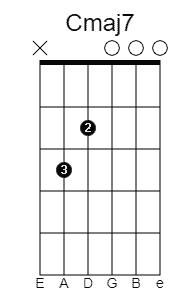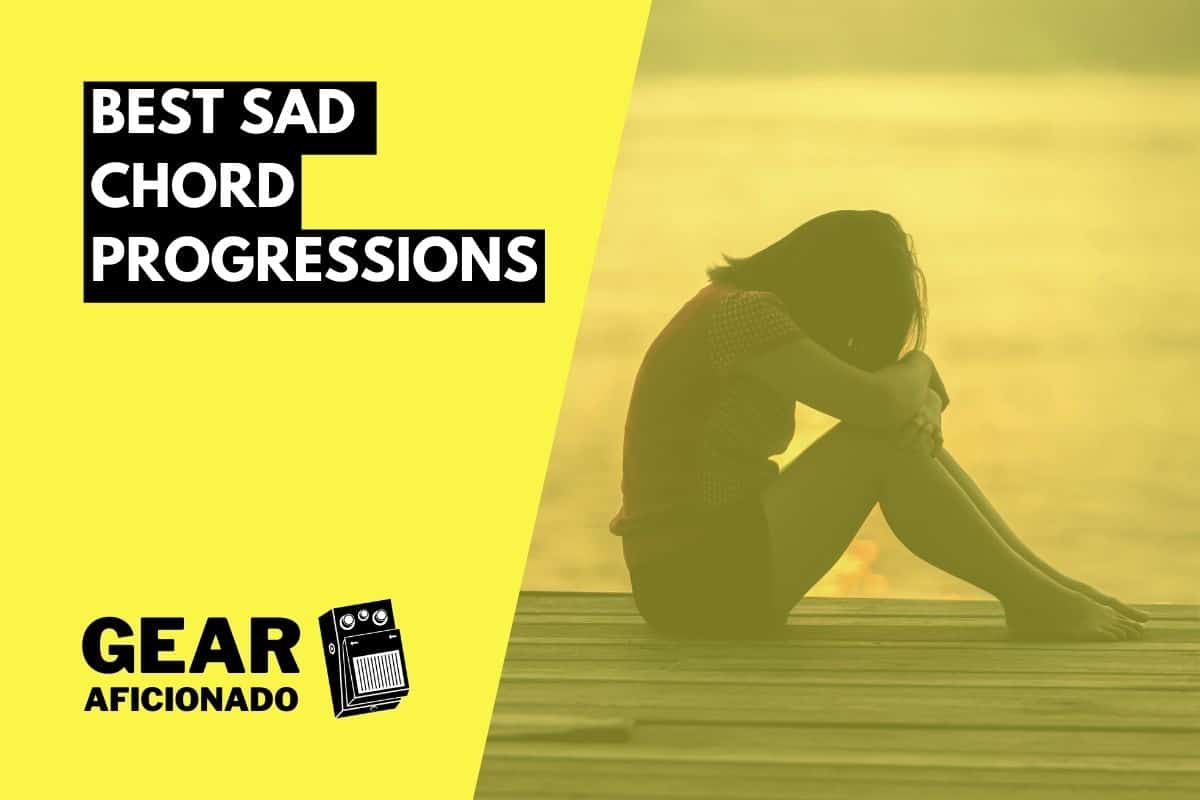Let’s face it, we all have at least one song that we listen to and get that beautiful sad, emotional vibe from.
Furthermore, I can speak from my own experience when I say that music has helped me overcome the darkest moments of my life.
There’s a beautiful little speech by actor Ethan Hawke explaining how we don’t pay much attention to poetry or art until we need it.
Well, music’s been there for me when I needed it.
Thus, this is my way of paying something back to the music creators who saved my life on more than one occasion.
I’m about to teach you how to create sad and emotional chord progressions that can touch and soothe the hearts and souls of those in need.
Are you ready? Get a disposable tissue box because it’s weeping time!
What Makes A Chord Progression Sad?
In music terms, when something sounds “sad”, it’s usually something that was planned from the beginning.
Indeed, the composer(s) of a musical piece can choose the quality of chords they put into a composition to generate an effect on the listener.
What you’ll hear the most in this vein is the “minor = sad” equation.
Yet, that’s not entirely true because to create a truly sad atmosphere you need a juxtaposition of elements.
In other words, you need to make minor and major chords clash a coexist to make the “sad” element of the minor chords stand out.
But minor chords are just the beginning, the entrance door to conveying sadness with chords.
Yes, you’re going to learn how to add the needed spices to take those minor chords to the next level.
Furthermore, while at it, you’ll also add some more layers of texture and complexity.
How to access this marvelous realm of sound?
I’m glad you asked, by adding the seventh note to the chords you already know.
Let’s look at some chords so you can get the foundations for your sad sonic empire.
Let’s Talk About Minor Chords
Minor chords differ from major chords by one note.
Yes, both chord types are triads made of the root, the third, and the fifth.
To form a major chord like C major, for example, you have to stack up the root (C), the third (E), and the fifth (G).
So, C major is C – E – G.
Just like major chords, minor chords are also made with a triad that involves the root, third, and fifth.
Nevertheless, that’s where similarities end because minor chords utilize a flat third that gives the chord that sour, bitter, sad taste.
For example, if we were to transform our C major into a C minor chord, we should lower the third by a semi-tone.
As a result, we have the root (C), the flat third (Eb), and the fifth (G).
So, C minor is C – Eb – G.
Let’s see what these chords look like on a guitar fretboard:


Taking any major chord you can think of and lowering the third will give you as a result its minor iteration.
You’ll realize that that little one-note difference means the world for these chords and what they can do for your chord progression.
Spice it Up using Seventh Notes
We’ve made our point and it’s now clear that you can add the sad factor by creating tension by juxtaposing major and minor chords.
But how can we take that to the next level in terms of feelings, texture, and power? Well, we can transform our minor chord into a minor seventh chord.
These chords, seventh chords, are not triads but chords with four notes.
Yes, to create a seventh chord, you need to add the seventh note of the scale to the triad of root, third, and fifth.
So, in a nutshell, by adding the fourth note you can create three kinds of chords:
- Maj7 Chords – Major seventh chords are made by simply adding the seventh note to the major triad. For example, if we were to create CMaj7, we should form our triad (C – E – G) and put the seventh note of the scale on top. Our chord will be formed with the notes C – E – G – B.
- Min7 Chords – To make minor chords even more powerful, we need to add the seventh note of the scale to our minor triad. So, if we want to put together our Cm7 chord, we have to form our minor triad (C – Eb – G) and add the seventh note of the scale. The outcome of this formula is C – Eb – G – B, AKA, the Cm7 chord.
- Dominant Seventh Chords – Wait, is this the seventh chord forged in the mounts of Mordor to rule all other seventh chords?! Well, I wish I had such an epic story to tell you but dominant seventh chords are what you play when you only see the number seven next to the chord name. These are the most common, powerful, and oldest seventh chords to appear in history. To create one, you have to add a flat seventh to your original chord. So, if you were to create a dominant seventh C chord, you should play the root (C), the third, (E), the fifth (G), and the flat seventh (Bb). So, a C7 is C – E – G – Bb. Just like we saw above, you can also use a minor triad as your base and come up with a minor dominant seventh chord: C – Eb – G – Bb.
Let’s see some examples of these chords on a guitar fretboard:



How to Get that Sad Tone on The Guitar?
Now that you’ve chosen the right chords for your progression, how do you make your guitar sound sad with a tone that will accompany the song’s atmosphere?
Well, after doing this for way over two decades I have a couple of insider tips to share with you.
Tremolo, The Sad Effect
If there’s one stomp box that is instantly sad is tremolo.
Indeed, with a tremolo effect on, every minor chord is potentially the soundtrack of an award-winning drama film.
There’s just something about the way it affects the sound that transforms the nuances of an arpeggiated progression or just the strumming of a chord into an instant weeping-inducing agent.
Some amplifiers like the Fender Deluxe Reverb feature valve-based tremolo, or you can also get it in stomp box version by a myriad of brands.
Try the chords above with and without tremolo and feel the difference.
Reverb to Make It Epic
If tremolo can add the sad factor, reverb can take that to the next level.
Indeed, the combination of reverb and tremolo is the quintessential dramatic tone to make the guitar cry or bleed.
For example, a pedal that never leaves my board is Strymon’s FLINT pedal.
It features reverb on one side and tremolo on the other, making it the perfect weeper-inducer for audiences of all musical genres.
Moreover, I often describe it as a Fenderizer pedal, because it brings that die-hard Fender combo amp combination to your pedalboard.
Don’t Shy Off from Delay Pedals
Before finishing this section, let me tell you that adding a nice delay pedal to that epic combination of tremolo and reverb can be great for creating an even sadder, more mysterious, and grandiloquent statement with your guitar.
The way I do it is by adding an analog delay to the effects chain.
My choice is the MXR Carbon Copy, which adds a darker flavor to the mix.
That being said, you can use any other delay pedal of your choice.
Just make sure to dial in enough repeats so that some of that tremolo can linger on after you’ve played your chord or arpeggio.
21 Sad & Emotional Chord Progressions
- I – V – vi – IV
- vi – IV – I – V
- iv – V
- IV – V – iii
- I – vi – IV – V
- IV – V – vi – I
- I/3 – Visus2 – V – vi
- I – VI – III – VII
- i – i/7 – IV/b4 – VI
- i – VII – IV – IV
- i – VII/1 – VI – V7
- I – V – vi – iii
- i – i/7 – IV/6 – VI
- I – v – v – ii
- ii7 – V7 – Imaj7
- i – i – bVI7 – V
- I – vi – ii – V
- i – III – V/VII – i – III – V/VII
- I – V – vi – IV – I – V
- I – IV/IV – bVI – V7
- i – IV/IV – v – VI
The Bottom End
Sad chord progressions have been the soundtrack of some of the most meaningful and obscure times in my life.
Therefore, as a way of paying it forward, I wanted to pass on some of my knowledge so you can write sad tunes that will help sad people for generations.
Don’t be afraid to shed some tears and convey some real emotions; that’s unleashing music’s true powers (yes, including the healing ones).
Happy (sad and emotional) playing!

Hello there, my name is Ramiro and I’ve been playing guitar for almost 20 years. I’m obsessed with everything gear-related and I thought it might be worth sharing it. From guitars, pedals, amps, and synths to studio gear and production tips, I hope you find what I post here useful, and I’ll try my best to keep it entertaining also.





